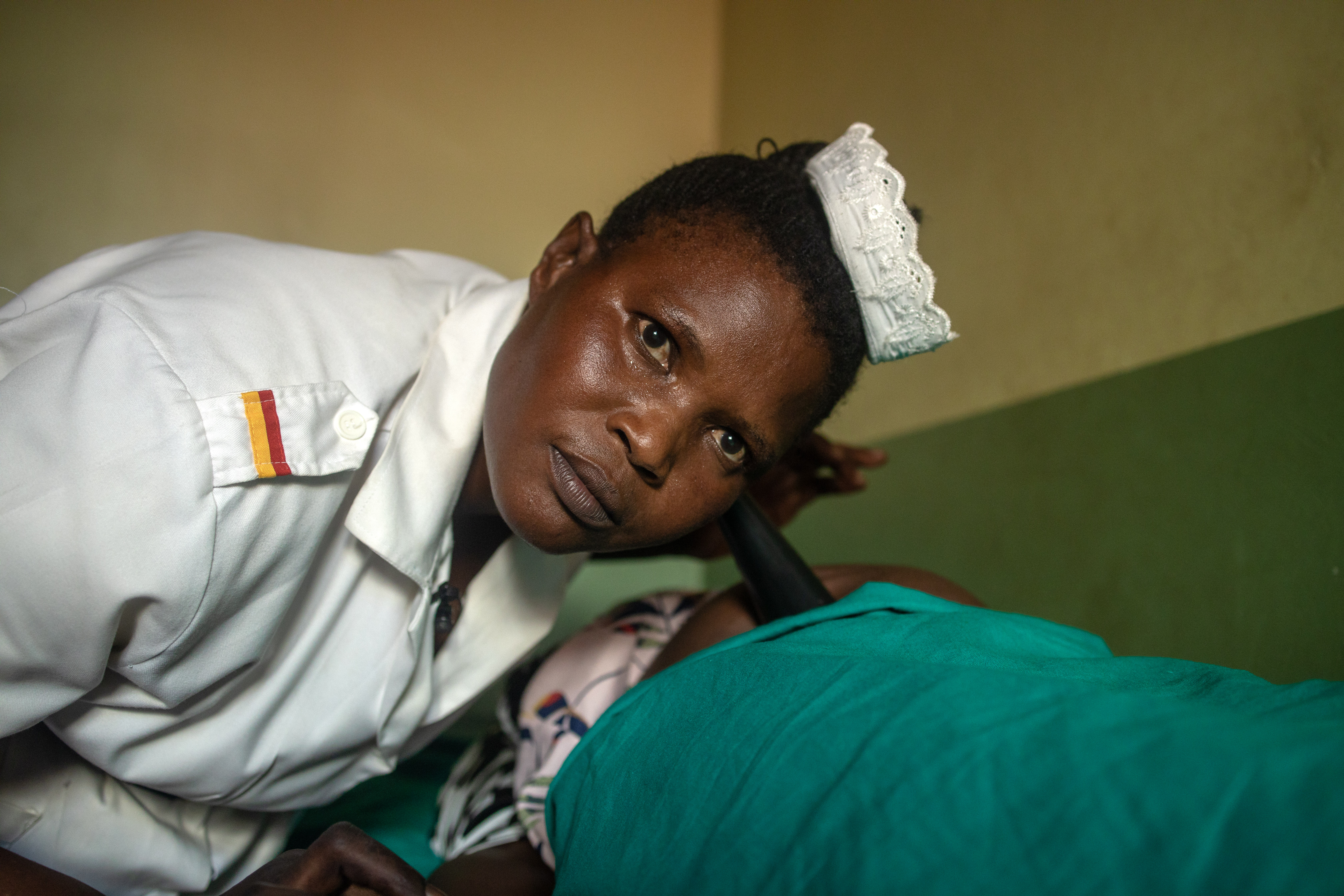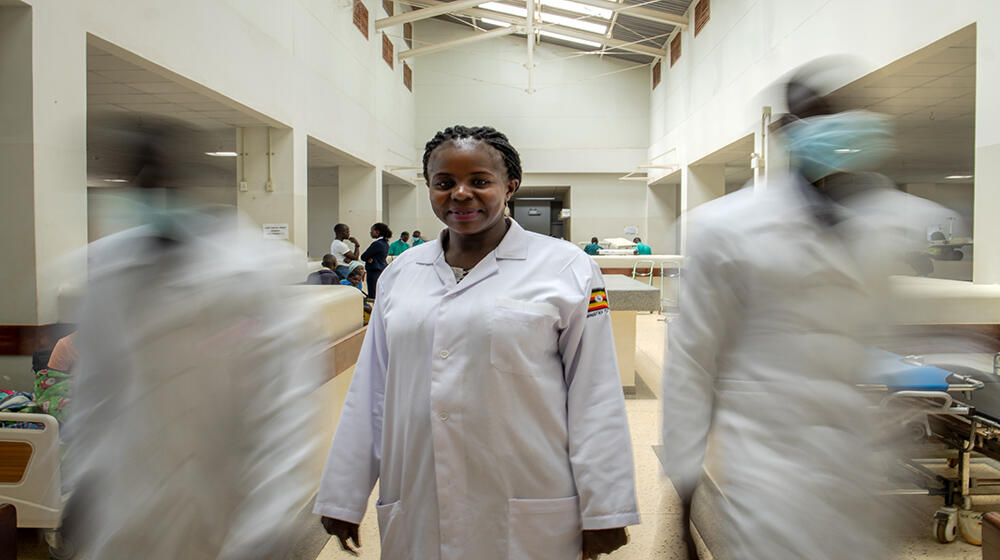Until only a few months ago, the senior-most medic in Amuru district doubted his own capabilities to handle emergency and delicate maternity complications. As District Health Officer, Dr. George Brown Oneka is the administrative superior of several other doctors, who also felt similar inadequacies.
It was not until July 2023 that Dr. Oneka had the opportunity to have this shortcoming solved, and the immediate beneficiaries were of course the mothers in the district, and ultimately the entire society in the northern Uganda region.
“I was privileged to attend a five-day essential training in operative obstetrics from Gulu, where I acquired much-needed skills in performing Caesarean Section (CS) using a better approach, especially on how to open the uterus in a way that minimizes bleeding,” Dr. Oneka explains. “I can now control bleeding using improvised balloon tamponade by using condoms, in the event of bleeding after childbirth.”
In the event the measures to control bleeding fail, Dr. Oneka can handle the situation with confidence, as he further explains: “In the event of all bleeding control measures failing, I am now confident to perform sub-total hysterectomy - removal of the main body of the uterus but leaving the cervix intact - and I can now also confidently perform B-lynch, that is suturing in refractory bleeding following childbirth.”
Dr. Baifa Arwinyo, who coordinated Acholi sub-region’s Local Maternity and Newborn System under the Advancing Sexual and Reproductive Health and Rights — ANSWER, confirms that the programme, which is funded by the Netherlands and supported by UNFPA, has benefited doctors working at the district hospitals and county facilities (Health Centres IV).

Speaking from Gulu Regional Referral Hospital where she leads the skilling of doctors at a modern simulation laboratory set up by ANSWER, Dr. Baifa cites some ‘fully fledged’ maternity hospitals with operating theatres like Atiak, whose doctors would never dare operate on any mother in labour who failed to deliver. They would instead refer them to the (university teaching) Gulu Regional Referral Hospital for life-saving surgeries that are so frequently required.
Using automated lifelike mannequin dummies of mothers and babies that simulate different actions and reactions that may occur during labour, the health workers gain confidence and experience without fear of making mistakes.
The different dummy organs that doctors and midwives handle - like the cervix and uterus have the feel of real human tissue, as do the artificial body fluids like blood that flows during the ‘operation’, complete with the right temperature and colour.
So strengthened are local maternity and newborn systems since the training of in-service doctors that referrals from the districts to the regional hospital in Gulu City of mothers in need of CS delivery that used to be the norm before this year have practically ceased.
Senior Midwife Jackline Ayikoru who assists in the simulation exercises explains how the cutting gets mare ‘real’ as the inexperienced doctors are given cow heart whose tissue under the surgical blade is very close in feel to the human uterus. To make the operations mare ‘real’, the lab staff also throw in some crushed watermelon whose look and feel is close to the “products of conception”.
Each and every little move by the doctor is recorded by high-resolution cameras and is played back for the instructors and the peers to critique. The high-tech equipment simulates all conceivable scenarios, from erratic labour contractions to the newborn turning blue due to lack of oxygen, while the doctors’ actions are all recorded on camera.
The facility, which was only second in the country to Mbarara Teaching Hospital (the third is coming up at Mulago National Referral Hospital), has so far trained eight doctors this year (2023) from the districts of Lamwo, Agago and Amuru.
Lamwo’s maternal health indicators were about the worst in the country two years ago, but the district is poised to come at the top in the first trimester ANC reporting. Meanwhile, doctors at Atiak Hospital in Amuru, who would not dare do a CS last year, are now preparing to make a how-we-got-there national presentation this year, thanks to the ANSWER programme that supported the training of medical doctors in the Acholi sub-region in the simulation lab.
But skilling does not end at the specialized training in the lab; it becomes a daily practice. Dr Baifa reveals that by using simple WhatsApp grouping, the Acholi sub-region now has 252 active participants constantly alert to posts by colleagues who are consulting over cases they are handling. This is further helping in bringing down maternal deaths.
“We realize that it is easier and definitely faster to move supplies than moving mothers in labour,” she explains. “A WhatsApp call for blood units of a given type prompts delivery to where the mother is being handled, definitely faster than mobilizing an ambulance and subjecting her to a road trip sometimes over difficult terrain.”
In addition to the daily consultations, all key ANSWER stakeholders in the sub-region hold a monthly online conference, powered by UNFPA, to asses, correct and align their operations for constant improvement.
Dr. Baifa says though they are “not yet there”, the improvement has been tremendous and a reasonable extension of the programme would seal the sustainability of the interventions.
She specifically points to the need to get deeper into the communities so they can play their role, especially to improve post-abortion handling. Indeed, the 11% reduction in seeking post abortion care (PAC) services registered across the 15 districts between 2021 and 2013 indicates the need for continued awareness sensitization so that all women and girls in need seek PAC intervention.
Written by Joachim Buwembo


